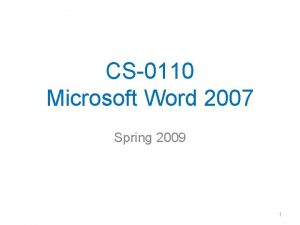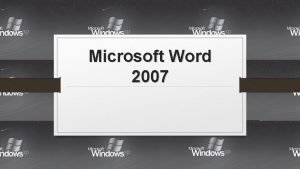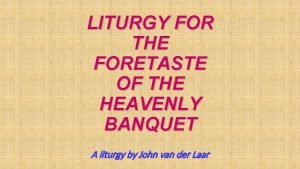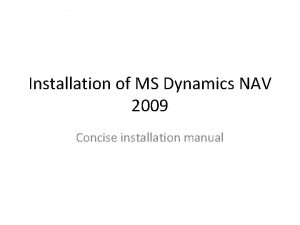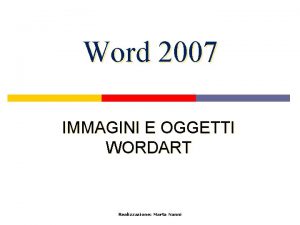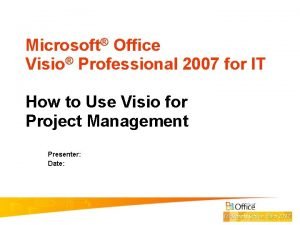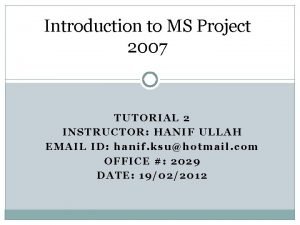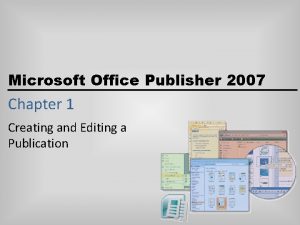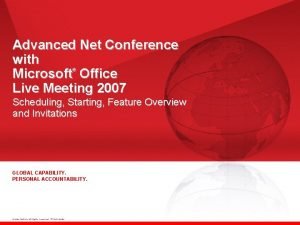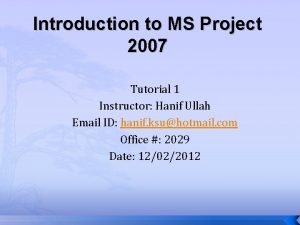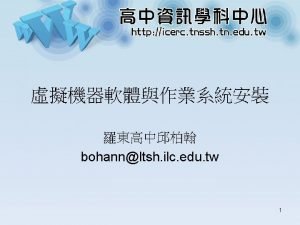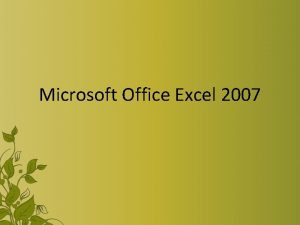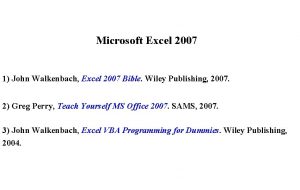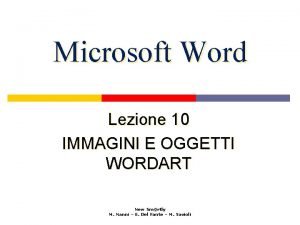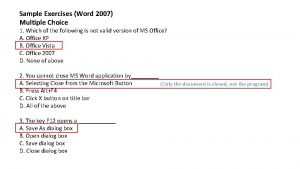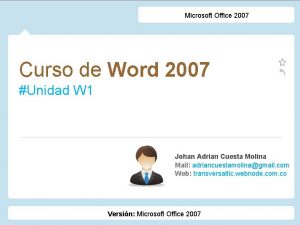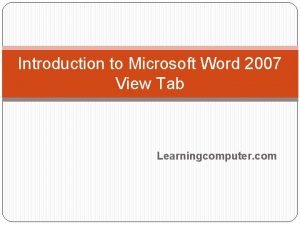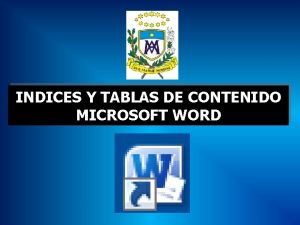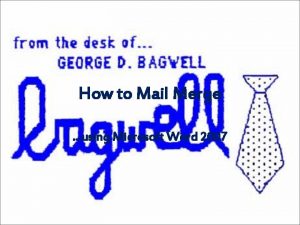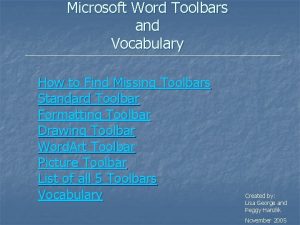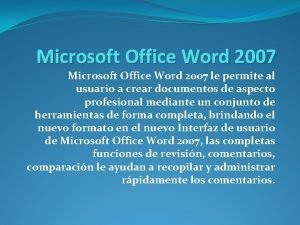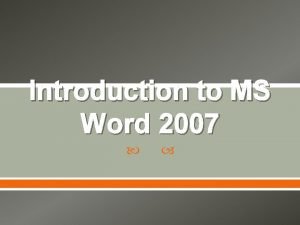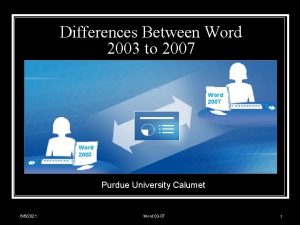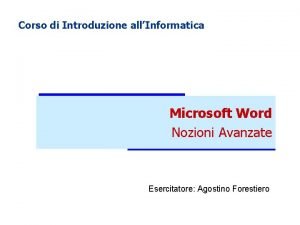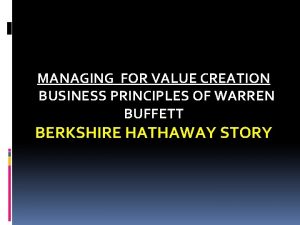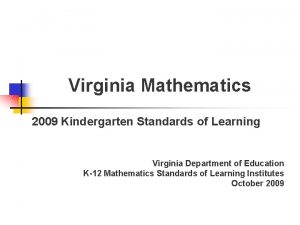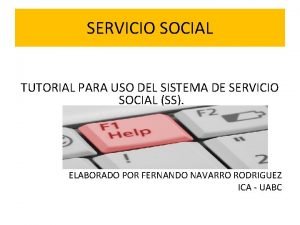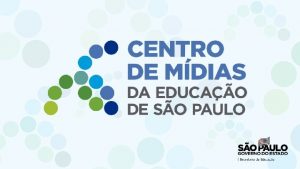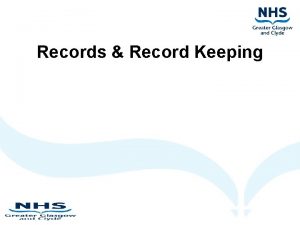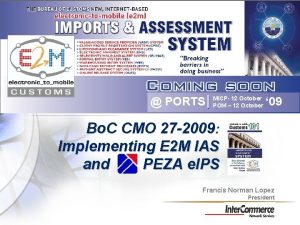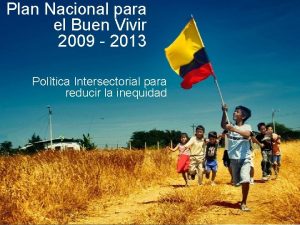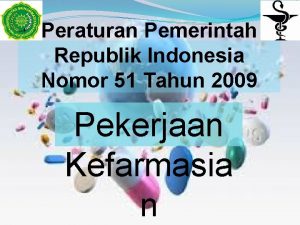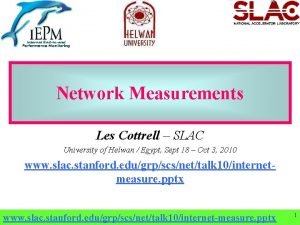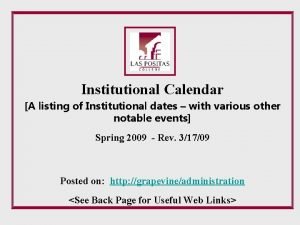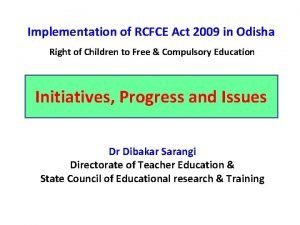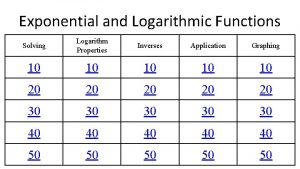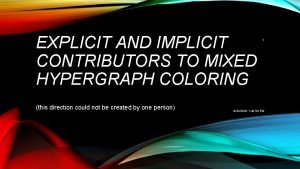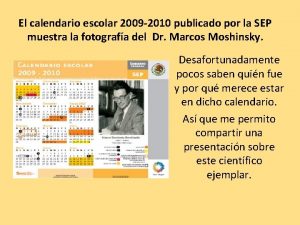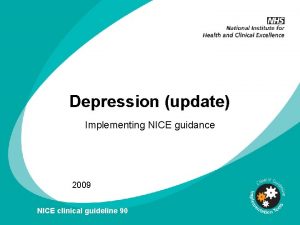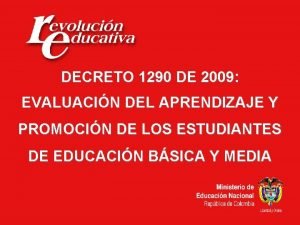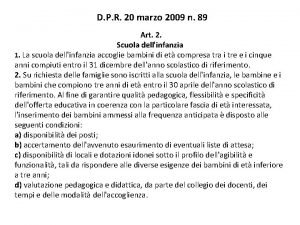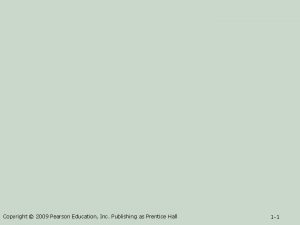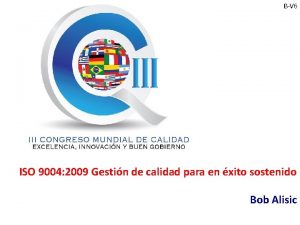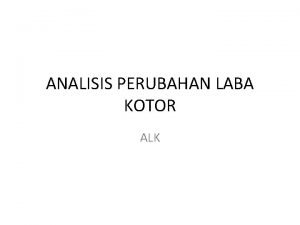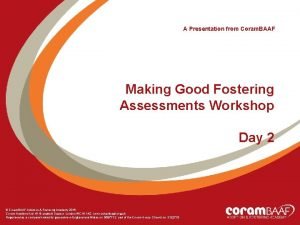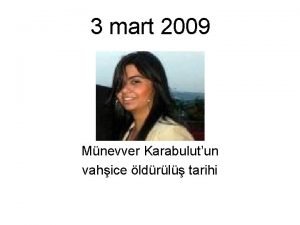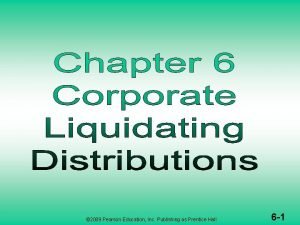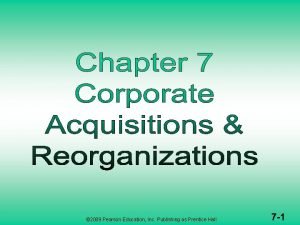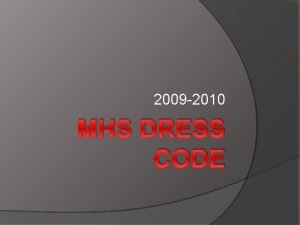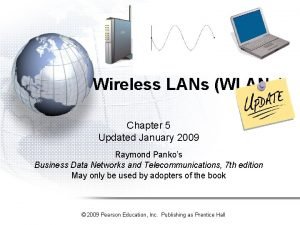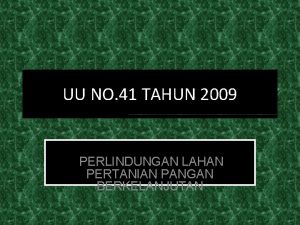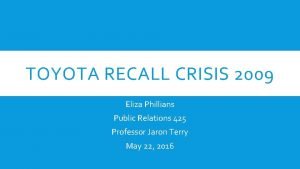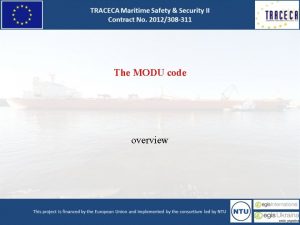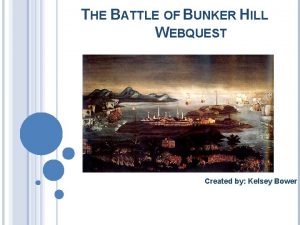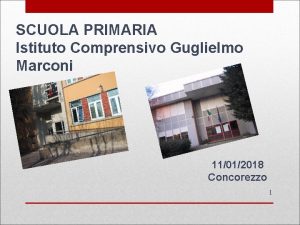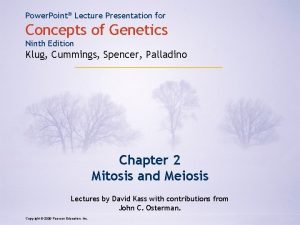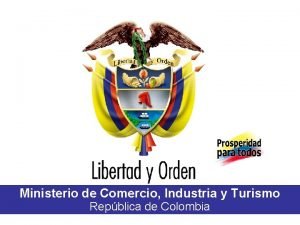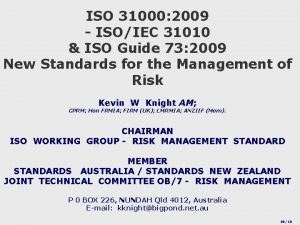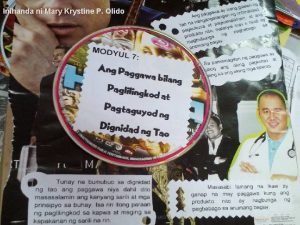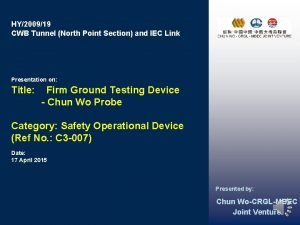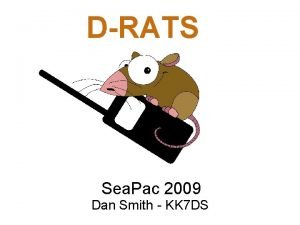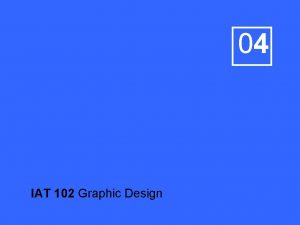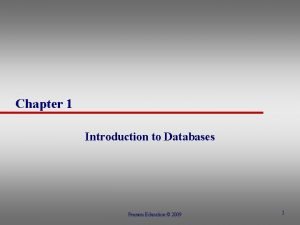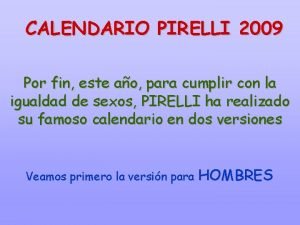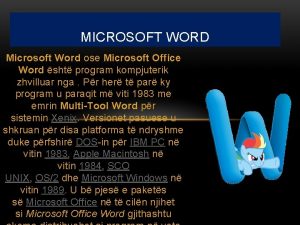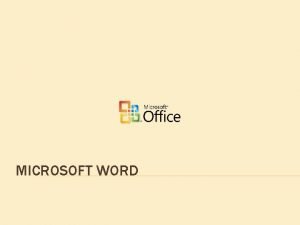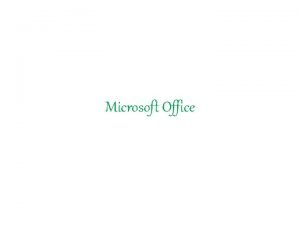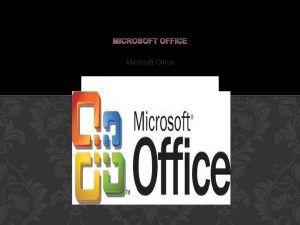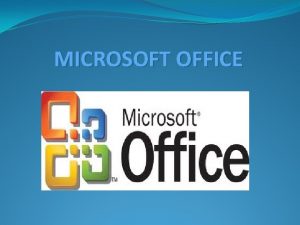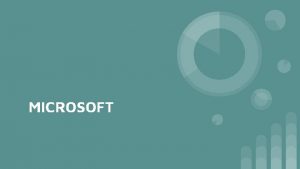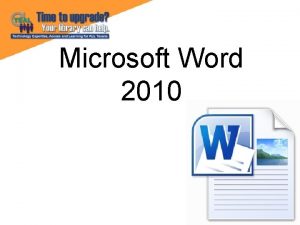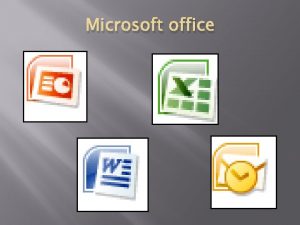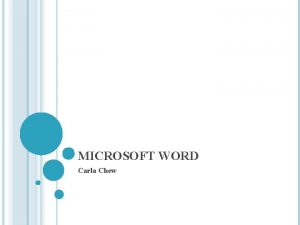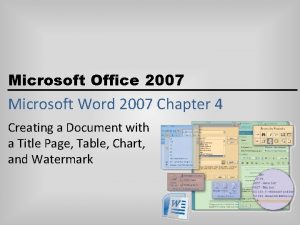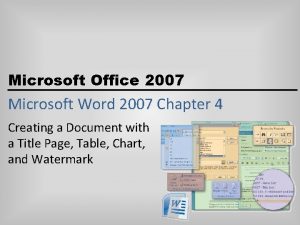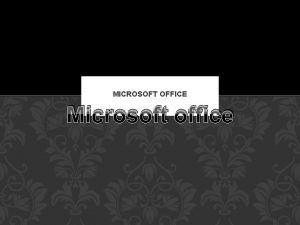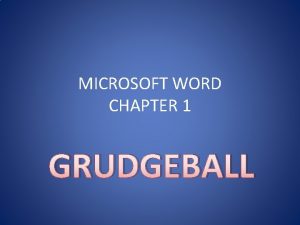CS0110 Microsoft Word 2007 Spring 2009 1 Word




















































































- Slides: 84

CS-0110 Microsoft Word 2007 Spring 2009 1

Word Processor • A word processor is an application used to create, edit, save and print chiefly textual based documents – Letters, Reports, Contracts, Essays, etc. • Modern replacement for the typewriter or electronic word processor • One of the earliest types of applications used on personal computers. 2

MS Word 2003 – menu – toolbar – insertion point – scroll bar – context menu – dialog box – function keys

MS Word 2007

Features of Word • Allows for fonts and text styling – Unlike straight text editors (e. g. Notepad) • Allows for precise page formatting – Margins – Columns – Tab Stops • Allows for the insertion of images, tables, graphs. • Performs spelling and grammar checks 5

Additional Word Features • Auto. Complete provides commonly used words and phrases, such as salutations and months. • Wordwrap determines if the next word in line will fit and move it to the next line if necessary.

Navigate the Word Window Navigating Using Keyboard Shortcuts To Move Press To the beginning of a document Ctrl + Home To the end of a document Ctrl + End To the beginning of a line Home To the end of a line End

Editing Text Fonts

Editing Text • Selecting text refers to highlighting. – drag with your mouse over text – selected text can be edited, formatted, copied, or moved • Formatting text sets the overall appearance of the text. – change the layout, color, shading, emphasis, or font characteristics of text

Fonts • A font is a complete character set that defines the shapes of the letters displayed • Fonts can take on a number of properties including: – Style – Size – Color – Justification 10

Font Formatting • Traditional Formatting – Font face (Arial, Times New Roman, Papyrus) – Font Style (Bold, Underline, Italic) – Font Size (16 pt, 24 pt) – Font Justification • Styling – Predefined or re-definable one-click styles – Carry semantic information (title, header, etc. ) 11

Traditional Font Formatting • Font Face • Font Size – By Value or Up/Down • Font Style – Bold, Italic Underline – Color – Left – Centered – Right – Justify – Line Spacing • Font Justification 12

Editing Fonts

Font Styling • Predefined font styles • Carry Meaning – Header, Title, etc. • Can be defined by hand • Entire document can be re-styled easily 14

Editing Text Layout

Layout • Document layout includes margins. • Paragraph layout includes line spacing, indents, and tabs. • Information about paragraph formats is stored in the paragraph mark at the end of a paragraph.

Paragraph Layout Line spacing is the distance between lines of text in a paragraph.

Justification Left Align Center Align The firm researches and prepares patents, litigates intellectual property infringement, handles licensing disputes, and prepares appeals. In the growing area of government contracts, the firm counsels its clients regarding United States government policymaking and prepares contracts according to government procurement policies. The firm’s experienced staff of attorneys Right Align Justify Align

Format Painter • Format Painter copies formatting of specific text or a paragraph and then applies it in other locations of document. • If you want to copy text formatting, select a portion of a paragraph. If you want to copy text and paragraph formatting, select an entire paragraph, including the paragraph mark.

Margins • Change page margins (top, bottom, left, and right) • Change margins for entire document or for just a portion of the document

Margins

Tab Stops • Tab stops – Mark specific locations on a line of text – Indent and align text – Double click a tab stop to change its properties

Leader Characters • Leader characters – Create a solid, dotted, or dashed line. – Draw the reader’s eye across the page from one item to the next. – When a dot is used for the leader, it is commonly referred to as a dot leader.

Tab Stops & Leader Characters

Leader Characters • Don’t use the period key to create a string of dots: – Proportional spacing causes periods to be spaced differently between rows. – Columns may look lined up on the screen, but will be crooked when printed.

Editing Text Reorganizing

Reorganizing Text • Office Clipboard is a temporary storage area that holds text. – Copy (Ctrl + C) text to move it onto the Office Clipboard. – Cut (Ctrl + X) text to remove it from its original location and place it in the Office Clipboard. – Paste (Ctrl + V) the contents of the Office Clipboard in a new location.

Reorganizing Text • Paste Options button – provides options for the Paste command • same as surrounding text • retain original formatting

Reorganizing Text

Reorganizing Text Undo Redo • Undo one or more actions made since last time saved • Redo reverses the Undo command

Reorganizing Text • Nonbreaking space – Keeps two words together so they are not split between two lines (CTRL-SHIFT-SPACE) • Nonbreaking hyphen – Keeps hyphenated terms, such as a zip code with the 4 -digit extension together (CTRLSHIFT-HYPHEN) • Manual line break – Ends a line of text – Moves the insertion point to next line without creating a new paragraph (SHIFT-ENTER)

Find and Replace • Finding and then replacing text is a quick way to change word(s) that appear more than one time in a document.

Editing Text Headers and Footers References

Headers and Footers • Headers and Footers – A header is information that prints at the top a page. – A footer is information that prints at the bottom of a page. • Text inserted into a header or a footer displays on every page of a document. • Headers or footers can have automatic page numbers, dates, times, the file name, and pictures. • To access, use the insert tab

Headers and Footers

References • References are used to credit information taken from another source. – A style is a built-in paragraph format that provides one step formatting of references. • Numbers mark the location of references within the text. • Footnotes are references placed at the bottom of the page. • Endnotes are references placed at the end of a document or chapter.

References

References • Adding a citation – In the Citations & Bibliography group, select the style for the citation. – Add the information about the source.

References

References • Source Manager dialog box – Copy sources from Master List to the current document. – Edit sources. – Preview the citations using the selected style.

References • Sample reference page using the MLA style guidelines

Editing Text Lists

Creating Lists • Bulleted lists – Use text symbols such as small circles or check marks. – Use bulleted lists when items can be displayed in any order. – Bullets can be customized to make any symbol a bullet.

Creating Lists • Numbered lists – Use consecutive numbers or letters. – Use numbered lists for items that have a sequence of actions or chronological order. – To end a list, press Enter twice or use Numbering or Bullets buttons as toggle buttons to turn on or off.

Creating Lists

Spelling and Grammar Check

Spelling & Grammar Check • Word checks spelling & grammar as you type – Spelling errors underline in red – Grammar errors underline in green – Awkward / unlikely constructions underline blue • Right click to view correction suggestions • F 7 manually runs a spelling check 47

Spelling & Grammar Check • Computer applied grammar rules can never be exact. • You need to check words flagged by Word. • Word does not check for usage. – Word will not flag the word sign as misspelled, even though you intended to type sing.

Spelling & Grammar Check

Auto Correct • Auto. Correct – Feature corrects common spelling errors as you type. • Type teh and Word automatically changes it to the. – You can add words to the list that you use frequently. (Word Options->Proofing->Auto Correct)

Graphics

Inserting • To insert pictures, tables, charts, etc into Word – Use the “Insert” menu on the Ribbon – Or copy and paste from another application – Or click and drag a file from Windows into the document 52

Working with Pictures • To manipulate pictures, select the image, and a new tab appears on the ribbon • Styles • Positioning and text wrapping • Size & Cropping 53

Designing Text • Word. Art – Decorative text you can edit and format – A gallery of text styles

Inserting Graphics • Picture tools display on the Ribbon. • The Picture command inserts picture as an inline object. • Sizing handles display around the edges of the picture: – Used to manually resize a graphic. – Corner sizing handles are round and proportionally resize a graphic.

Inserting Graphics

Formatting Graphics • Floating object: – A graphic that can be moved independently of the surrounding text – Accomplished by changing the wrapping options

Formatting Graphics

Formatting Graphics • Picture styles add sophisticated visual features to your pictures.

Formatting Graphics • Page borders frame the page.

Text Boxes • Text box – A movable, resizable container for text that can have formatting applied to it – Useful to give text a different orientation from other text – Can be placed anywhere in the document like a floating object – Can be placed outside the document margin

Text Boxes

Tables

Working with Tables • To add a table, go to the insert tab of the ribbon, and select “insert table” – Drag the mouse to select the size of table you want • To edit a table’s style, select it and a new tab will appear on the ribbon 64

Working with Tables • You can also modify the structure of a table by using the “layout” tab – add & remove cells – cell sizing & justification – more on working with tabular data when we get to Excel 65

Tables • Tables – Consist of rows and columns – Are used to organize data

Using a Table • Ways to move around a table – Tab moves you from cell to cell. – Shift + Tab moves you to the previous cell. – Up or down arrow keys move you up or down a column. – Left and right arrow keys move the insertion point one character at a time within a cell.

Using a Table • Word provides a tool to convert existing text into a table. – The text must be marked using separator characters (usually tabs or commas) that separate the text in each line. – Word adjusts the column widths as it converts the text.

Formatting a Table • Formatted tables are more attractive and easier to read. • Formatting tools – Shade cells – Format table borders and grid – Align text – Center the table between the document margins

Formatting a Table • Modify or remove the border from the entire table, cell, or parts of a cell.

Formatting a Table • Merge cells to position the table title across the columns.

Formatting a Table • Word includes a number of built-in table formats called Table Styles. • Table Styles: – Predefined sets of formatting characteristics • Fonts • Alignment • Cell shading

Formatting a Table • Examples of two Table Styles

Finishing a Document Viewing and Printing

Document Views • There are five ways to view your document on the screen. – Print Layout: displays document as it will look printed – Full Screen Reading: creates easy-to-read pages to increase legibility – Web Layout: shows how the document will look as a Web page – Master Document Tools: shows document headings and subheadings – Draft: simplifies the page layout for quick typing

Document Views • Word enables you to split the screen. – Look at two different parts of the same document at the same time. • View the first and the last pages of long documents at the same time. – View two different documents side-by-side and make comparisons between the two.

Document Views

Printing a Document • Print Preview – While creating the document, display Print Preview to ensure you are getting the result you want. – Before printing, make a final preview to verify the layout is what you intended.

Printing a Document • Quick Access Toolbar – Click Print to print a single copy on the default printer. • Print dialog box – Use it to select number of copies, printer, and which pages to print. – Open it from the Office menu, Ctrl+P, or Alt+F+P.

Printing a Document

Microsoft Help

The Microsoft Help System • Enter key words and phrases to get information and step-by-step instructions. • Help is available on your computer, online, and within Screen. Tips.

The Microsoft Help System

Some information in these lectures is influenced by or derived from Prof. George Novacky, Dr. Yasir Khalifa, Pearson Prentice Hall, and/or John Knox’s CS-0110 lecture materials. Additional images are obtained from stock. xchng or the Wikipedia Commons under either a royalty-free or GNU license. 84
 Microsoft word 2009
Microsoft word 2009 Microsoft word 2007 dapat dijalankan dengan menggunakan
Microsoft word 2007 dapat dijalankan dengan menggunakan Foretaste of spring 2007
Foretaste of spring 2007 Four seasons korean movie
Four seasons korean movie Winter spring summer and fall
Winter spring summer and fall Microsoft dynamics nav 2009 installation guide
Microsoft dynamics nav 2009 installation guide Word 2007 word art
Word 2007 word art Microsoft official academic course microsoft word 2016
Microsoft official academic course microsoft word 2016 Microsoft official academic course microsoft word 2016
Microsoft official academic course microsoft word 2016 Office 2007 project
Office 2007 project Microsoft office visio 2007
Microsoft office visio 2007 Project 2007 tutorial
Project 2007 tutorial Ms publisher 2007
Ms publisher 2007 Microsoft groove 2007
Microsoft groove 2007 Office live meeting 2007
Office live meeting 2007 Microsoft office 2007 wiki
Microsoft office 2007 wiki Tutorial project 2007
Tutorial project 2007 Virtual pc 2007
Virtual pc 2007 Macam macam ikon dan fungsinya
Macam macam ikon dan fungsinya Microsoft excel 2007
Microsoft excel 2007 Word art microsoft word
Word art microsoft word How to create multiple choice questions in word 2007
How to create multiple choice questions in word 2007 Curso de word 2007
Curso de word 2007 Ms word 2010 view tab
Ms word 2010 view tab Indice en word 2007
Indice en word 2007 Mail merge word 2007
Mail merge word 2007 Word standard toolbar
Word standard toolbar Micro office word 2007
Micro office word 2007 Ms word 2007 introduction
Ms word 2007 introduction Word 2003 to 2007
Word 2003 to 2007 Sinionimi
Sinionimi Microsoft official academic course microsoft excel 2016
Microsoft official academic course microsoft excel 2016 Microsoft windows startwarren theverge
Microsoft windows startwarren theverge Microsoft office excel merupakan program aplikasi
Microsoft office excel merupakan program aplikasi 2008-2009 school year
2008-2009 school year Virginia kindergarten standards
Virginia kindergarten standards Siss uabc
Siss uabc Uma maquina fotografica custava 400 no dia dos pais
Uma maquina fotografica custava 400 no dia dos pais Legible meaning
Legible meaning Cmo 27-2009
Cmo 27-2009 Plan nacional del buen vivir 2009 al 2013
Plan nacional del buen vivir 2009 al 2013 Pp 51 tahun 2009
Pp 51 tahun 2009 R.t.t. 2009
R.t.t. 2009 January 2006 chemistry regents answers
January 2006 chemistry regents answers Institutional calendar
Institutional calendar Rcfce
Rcfce Impaact 2009
Impaact 2009 In 2009 there were 1570 bears
In 2009 there were 1570 bears Rosa catania 2009
Rosa catania 2009 Calendario escolar 2009-2010
Calendario escolar 2009-2010 Nice 2009
Nice 2009 Decreto 1290 de 2009
Decreto 1290 de 2009 Dpr 89/2009
Dpr 89/2009 2009 pearson education inc
2009 pearson education inc 2009 delmar cengage learning
2009 delmar cengage learning 2009 delmar cengage learning
2009 delmar cengage learning Medical terminology learning exercises chapter 1
Medical terminology learning exercises chapter 1 Iso 9004 2009
Iso 9004 2009 Contoh soal analisis perubahan laba kotor
Contoh soal analisis perubahan laba kotor Sunny's adventure 2009
Sunny's adventure 2009 Discrepancy matrix
Discrepancy matrix Münevver karabulut
Münevver karabulut 2009 pearson education inc
2009 pearson education inc 2009 pearson education inc
2009 pearson education inc 2009 dress code
2009 dress code The name of yashpal committee report 1993 is
The name of yashpal committee report 1993 is Pearson 2009
Pearson 2009 Graphing tpr
Graphing tpr Uu no 41 tahun 2009
Uu no 41 tahun 2009 Toyota recall crisis 2009
Toyota recall crisis 2009 Modu safety certificate
Modu safety certificate Bunker hill 2009
Bunker hill 2009 Istituto comprensivo concorezzo
Istituto comprensivo concorezzo Pearson 2009
Pearson 2009 Decreto 2680 de 2009
Decreto 2680 de 2009 Iso guide 73:2009
Iso guide 73:2009 Mahalagang layunin sa paggawa
Mahalagang layunin sa paggawa Hy/2009/19
Hy/2009/19 2009
2009 Siat 2009
Siat 2009 Copyright 2009 pearson education inc
Copyright 2009 pearson education inc Copyright 2009 pearson education inc
Copyright 2009 pearson education inc Pearson 2009
Pearson 2009 Pearson education 2009
Pearson education 2009 Calendario pirelli 2009
Calendario pirelli 2009
